

Japanese pagodas in earthquakes.
CDSA - La sismologie aux Petites Antilles. Pour votre information, cette publication n'est normalement pas destinée au profil utilisateur que vous avez sélectionné.
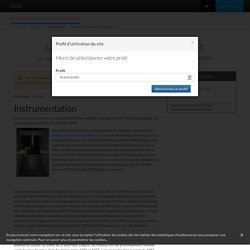
Précédent : Séismes La toute première station sismique des Petites-Antilles a été installée sur l'Île de Trinidad par les scientifiques de la Navy des USA dès 1898. Les premiers instruments sismologiques des Antilles françaises, des pendules de fabrication Bosh-Omori sont installés par Alfred Lacroix à la suite de l'éruption de 1902 de la Montagne Pelée en Martinique. Il ne s'agissait pas encore d'instruments permanents et pérennes. C'est en 1936 que des instruments plus perfectionnés sont installés lors de la construction de l'Observatoire Volcanologique et Sismologique de la Martinique.
Les premières stations sismologiques à capteurs électromagnétiques ont été mises en place à partir de 1946 en Martinique. Actuellement, les réseaux sismologiques enregistrent plusieurs séismes par jour en moyenne dont certains peuvent être ressentis par la population. Phonemic chart. Learn. Great ShakeOut Earthquake Drills - Drop, Cover, and Hold On. Federal, state, and local emergency management experts and other official preparedness organizations all agree that "Drop, Cover, and Hold On" is the appropriate action to reduce injury and death during earthquakes.
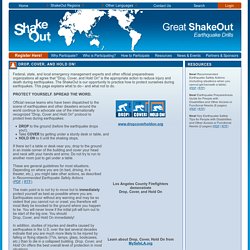
The ShakeOut is our opportunity to practice how to protect ourselves during earthquakes. This page explains what to do-- and what not to do. Official rescue teams who have been dispatched to the scene of earthquakes and other disasters around the world continue to advocate use of the internationally recognized "Drop, Cover and Hold On" protocol to protect lives during earthquakes: DROP to the ground (before the earthquake drops you!) Earthquake Country Alliance: Seven Steps to Earthquake Safety. During the next big earthquake, and immediately after, is when your level of preparedness will make a difference in how you and others survive and can respond to emergencies.
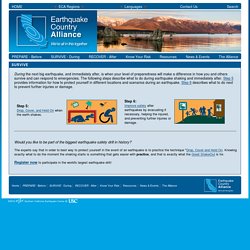
The following steps describe what to do during earthquake shaking and immediately after. Step 5 provides information for how to protect yourself in different locations and scenarios during an earthquake. Step 6 describes what to do next to prevent further injuries or damage. Would you like to be part of the biggest earthquake safety drill in history? The experts say that in order to best way to protect yourself in the event of an earthquake is to practice the technique "Drop, Cover and Hold On. Register now to participate in the world's largest earthquake drill! Earthquake Country Alliance: Seven Steps to Earthquake Safety. After the next big earthquake, your recovery and that of the community may take weeks to months or even longer.
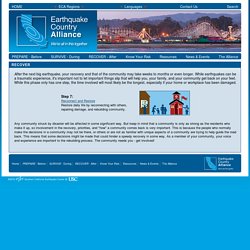
While earthquakes can be a traumatic experience, it's important not to let important things slip that will help you, your family, and your community get back on your feet. While this phase only has one step, the time involved will most likely be the longest, especially if your home or workplace has been damaged. Any community struck by disaster will be affected in some significant way.
But keep in mind that a community is only as strong as the residents who make it up, so invoivement in the recovery, priorities, and "how" a community comes back is very important. This is because the people who normally make the decisions in a community may not be there, or others or are not as familiar with unique aspects of a community are trying to help guide the road back.
Weather Wiz Kids weather information for kids. Volcanoes (Volcanoes are not associated with weather, but instead are natural disasters.)
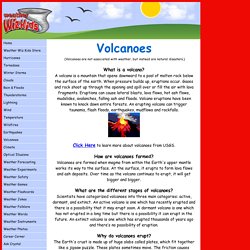
What is a volcano? A volcano is a mountain that opens downward to a pool of molten rock below the surface of the earth. When pressure builds up, eruptions occur. Gases and rock shoot up through the opening and spill over or fill the air with lava fragments. Eruptions can cause lateral blasts, lava flows, hot ash flows, mudslides, avalanches, falling ash and floods. Click Here to learn more about volcanoes from USGS. How are volcanoes formed? What are plate tectonics? Click Here to learn more about plate tectonics and the drifting of our continents. How many volcanoes are there? What are the different types of volcanoes? What is the difference between lava and magma?
Why does lava take a long time to cool down? What is a pyroclastic flow? Disney Digital Books Reader. Precaution before during & after volcanic eruption. Earthquake Country Alliance: Seven Steps to Earthquake Safety. Drop, Cover, and Hold On when the earth shakes.

Taking the proper actions, such as "Drop, Cover, and Hold On", can save lives and reduce the risk of injury. Weather Wiz Kids weather information for kids. Volcanoes blast hot, solid and molten rock and gases into the air.

As a result, ash can fall hundreds of miles downwind of a volcano. If you live near a volcano, active or dormant, be prepared to follow instructions from your local emergency officials by listening to the radio and television. Volcanoes occur on the West Coast, in Alaska and in Hawaii. Have a disaster plan. Know whether or not you are at risk for danger. Follow the evacuation order issued by authorities. Cover you mouth and nose. Earthquake Country Alliance: Seven Steps to Earthquake Safety. Improve safety immediately after an earthquake by evacuating if necessary, helping the injured and preventing further injuries or damage.
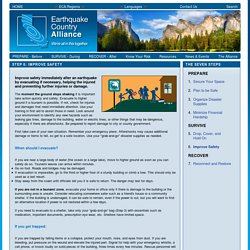
The moment the ground stops shaking it is important take action quickly and safely. Evacuate to higher ground if a tsunami is possible. If not, check for injuries and damages that need immediate attention. Use your training in first aid to assist those in need. Earthquake Country Alliance: Seven Steps to Earthquake Safety. Health Guidelines English WEB.